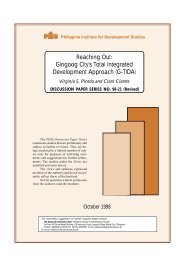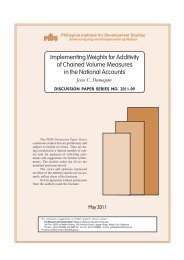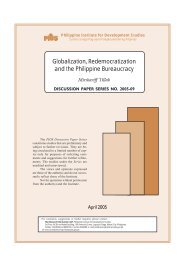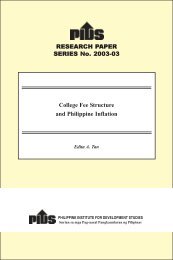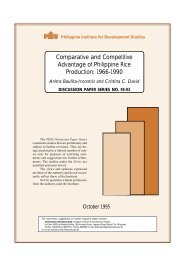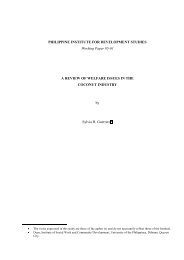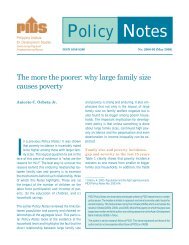Effects of the Five Percent Uniform Tariff - Philippine Institute for ...
Effects of the Five Percent Uniform Tariff - Philippine Institute for ...
Effects of the Five Percent Uniform Tariff - Philippine Institute for ...
You also want an ePaper? Increase the reach of your titles
YUMPU automatically turns print PDFs into web optimized ePapers that Google loves.
as it increases by more than <strong>the</strong> output growth rate brought about by <strong>the</strong> increase in output insectors with high value-added sectors. 7The price effect which comes from <strong>the</strong> lowering <strong>of</strong>tariff rates toge<strong>the</strong>r with positive income effects generates a huge increase in final demand.In this scenario imports increase due to <strong>the</strong> combined increase in final demand and <strong>the</strong> outputdecline in <strong>the</strong> import-competing sectors and this increase in imports is more than <strong>the</strong> increasein exports. As a result, <strong>the</strong>re is a trade deficit <strong>of</strong> about P732 M or 2.6% <strong>of</strong> GDP.The simulation results reported in Table 12 are consistent and <strong>the</strong>re<strong>for</strong>e, comparablewith <strong>the</strong> scenarios in Table 11. The main difference is that Table 12, <strong>the</strong> partial equilibriummodel becomes quasi-general equilibrium because <strong>of</strong> <strong>the</strong> introduction <strong>of</strong> an exchange ratevariable. There are two parts to this simulation exercise: first, <strong>the</strong> model solves <strong>for</strong> <strong>the</strong> changein <strong>the</strong> exchange rate that is compatible with some change in <strong>the</strong> trade balance. This is shownin equation (9.15) in part III <strong>of</strong> <strong>the</strong> paper. Second, once this change in <strong>the</strong> real exchange rateis known, <strong>the</strong> estimation <strong>of</strong> changes in output and <strong>the</strong> rest <strong>of</strong> <strong>the</strong> variables can proceed.Caution here is emphasized that <strong>the</strong> ensuing changes in <strong>the</strong> variables are consistent with somelevel <strong>of</strong> trade balance. Never<strong>the</strong>less, to make <strong>the</strong> exercise simpler, <strong>the</strong> simulation model solves<strong>for</strong> <strong>the</strong> change in <strong>the</strong> real exchange rate that is consistent with no change in <strong>the</strong> trade balance.In o<strong>the</strong>r words, <strong>the</strong> level <strong>of</strong> trade balance after re<strong>for</strong>m will be <strong>the</strong> same as it was be<strong>for</strong>e re<strong>for</strong>m.The simplicity here lies in that <strong>the</strong> model does not need to know what <strong>the</strong> real exchange rateis be<strong>for</strong>e re<strong>for</strong>m and after re<strong>for</strong>m; all it does is compute <strong>for</strong> <strong>the</strong> change.The required change in <strong>the</strong> exchange rate to set <strong>the</strong> change in <strong>the</strong> trade balance to zeroin cases A to D are shown in Table 12. Since all <strong>the</strong> first three cases, A,B and C posted tradesurpluses, <strong>the</strong>n <strong>the</strong> real exchange rate needs to appreciates to balance <strong>the</strong> trade. In cases Eand G, <strong>the</strong> peso needs to appreciate by about 0.8% to wipe out a trade surplus <strong>of</strong> P2.92B incase A and P5.56B in case C. Supply is more elastic in case G; <strong>the</strong>re<strong>for</strong>e, <strong>the</strong> same 0.8% realappreciation in <strong>the</strong> currency can balance a larger trade surplus. In case B, <strong>the</strong> required changeis less than .01% because <strong>the</strong> trade surplus is only about P134 M. Of course, <strong>the</strong> currencyshould not appreciate because it will send conflicting signals to economic agents. Anappreciation <strong>of</strong> <strong>the</strong> peso will hurt exports and encourage more imports. Ano<strong>the</strong>r factor is <strong>the</strong>growth rate in output is very small and discouraging at 0.1% in case E and 0.2% in case G.The currency appreciation acutally translates to a lower growth rate when compared to <strong>the</strong>growth rates in cases A and C. The currency need not appreciate because <strong>the</strong>re are o<strong>the</strong>r policytools availablethat can be use to expand <strong>the</strong> economy. For instance, monetary authorities canincrease money supply or lower interest rates.Only in case H will <strong>the</strong> peso need to depreciate in real terms by 0.1% to erase a tradedeficit <strong>of</strong>P732 M. The added bonus is that output will grow by 1.1% relative to <strong>the</strong> 1.04%in case D. In case H, <strong>the</strong> are now two prices that dirves growth in output: <strong>the</strong> change inrelative prices and <strong>the</strong> real exchange rate. The growth will be contributed mainly by <strong>the</strong>manufacturing sector with a growth rate <strong>of</strong> 1.63%; never<strong>the</strong>less, <strong>the</strong> output in agriculturewill fall by 1.2%. Income will also grow by an impressive 2.51% brought about by <strong>the</strong>increase in output <strong>of</strong> <strong>the</strong> high value-added sectors.What does it mean if <strong>the</strong> peso needs to depreciate by 0.1% in real terms? Assume that<strong>the</strong> domestic inflation rate is 6%, 3% <strong>for</strong> its major trading partners and that <strong>the</strong> nominalexchange rate <strong>of</strong> <strong>the</strong> trading partners are stable during <strong>the</strong> period year 2000 to year 2004.43




